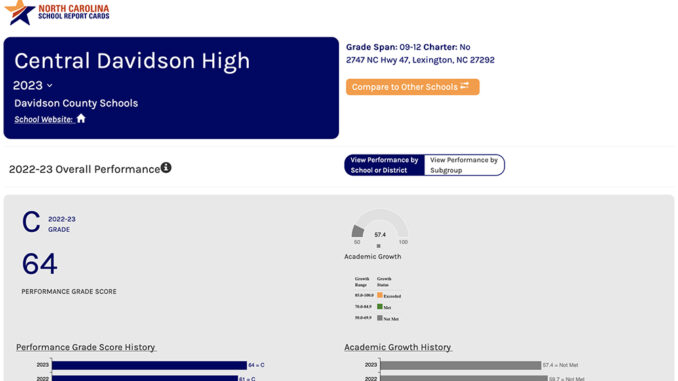
RALEIGH — The way the state grades its public schools may be getting a redesign according to a presentation given by N.C. State Superintendent Catherine Truitt to the House Select Committee on Education Reform on Feb. 26.
Almost a decade ago, lawmakers passed a law creating an A-F grading system that bases a letter grade for each school on an achievement score, weighted at 80%, and on the academic growth of students, which is weighted at 20%.
Since its inception, the A-F system has drawn criticism for relying too much on test scores and not considering other metrics that can impact a particular school and, in some cases, end up penalizing low-wealth or low-performing districts.
Truitt, along with Deputy Superintendent Michael Maher, told lawmakers the current A-F system does not provide a full, accurate view of school performance. Truitt outlined that part of the problem was being beholden to compliance with certain federal guidelines.
“So the solution that we are going to present to you today is a multi-measure model of school performance that moves beyond compliance with federal guidelines,” said Truitt. “Because, folks, the federal government right now is driving the way we do school accountability in North Carolina, and we need to replace it with a model that represents our North Carolina educational values.
“We have to do more than simply look at test scores that occur on one day of the year at the end of the year or semester. We must absolutely be as transparent as possible about the percentage of students who are proficient in reading and proficient math, but there has to be more than that.”
Truitt’s proposal would include adding more metrics to include career preparation, student attendance, graduation rates and educator surveys on school climate. Additionally, the proposal suggests updating the school grading website rolled out under her predecessor, Mark Johnson, to make it easier to understand for parents.
Instead of one letter grade, the new “multi-measure model” for schools would receive four individual grades for Academics, Progress, Readiness and Opportunity.
The Academics grade would measure student proficiency in math, reading and science, while the Progress grade measures school growth based on data from the Education Value-Added Assessment System, or EVAAS for short.
Readiness grades would measure student post-secondary preparedness, including high school graduation rates, and Opportunity would consider items like chronic absenteeism, school climate and intra/extra-curricular activities.
“Right now in North Carolina, only 30% of high schoolers are graduating every year and getting any kind of credential of value, two-year degree or four-year degree, by the age of 24,” Truitt said. “This (is) despite the fact that we have data that show that our students have earned more career and technical education credentials than at any time in state history. Yet it’s not converting to either being enlisted, employed or enrolled when they graduate from high school.”
Truitt also said low-performing schools were not receiving “meaningful accountability” under the current model and therefore were not receiving the appropriate support. The presentation given by Truitt and Maher underscored that point, stating that the “state accountability model (80/20) and federal accountability model (ESSA) are not aligned — making it difficult to know if schools are improving.”
Overall, the shift to a more expansive school grading system would take place in phases over three years. The first year would involve a pilot program that will examine certain selected schools that will implement both grading models. The second year would pull the rest of the state’s schools into the mix, using both models. The final year would see all schools transfer to using the new model.
Truitt asked lawmakers to act on the model by allowing the pilot to commence during the 2024-25 school year.
The new A-F model was developed by a working group that was formed in 2022.
The working group had conversations with multiple stakeholder groups, which a Department of Public Instruction press release characterized as a “bipartisan advisory group of educators, superintendents and charter leaders, public policy experts and NCDPI staff members. Additionally, 50 district superintendents helped hammer out the final version that was presented to lawmakers at the committee meeting.



